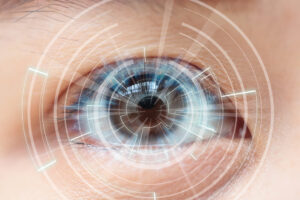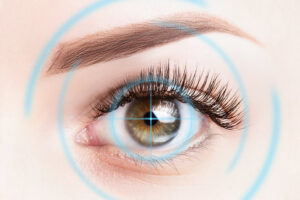
Have you ever experienced a sore eyelid or dry, itchy eyelids that didn’t go away after warm compresses, showering, or carefully washing the area? If so, you aren’t alone. This condition, called blepharitis, is one of the most common reasons besides vision screen or vision problems that send patients to an optometrist or ophthalmologist.
Blepharitis is a Common Eyelid Infection Among Contact Lenses Wearers
Blepharitis is pretty common as far as eyelid infection goes. It’s caused by bacteria or fungi that infect the edges of the eyelids. It’s not unusual to see it in people who wear contact lenses and touch their eyelids a lot as they insert and remove them. Its calling card, so to speak, is dry skin on an eyelid that won’t go away.
People with dry eye problems often develop blepharitis. The two are related and it’s not always clear what came first — the dry eye or blepharitis. Both occur when the Meibomian glands, that secrete oil to prevent tears from drying up, become blocked or otherwise stop functioning.
Other people who are susceptible to blepharitis (regardless of whether they wear contact lenses or not) include people who suffer from different types of dermatitis that can spread to the face. Blepharitis can appear as eczema around the eyes in people who have the condition to begin with, as well as those who have rosacea, psoriasis, or even dandruff. It often occurs with pinkeye (conjunctivitis), which is highly contagious. Blepharitis by itself is not contagious.
Not all eyelid problems are blepharitis. Eyelid dermatitis or a rash around the eye could be caused by a type of eye mite called Demodex that typically live on the face. When they overwhelm an eyelid, they produce symptoms similar to blepharitis.
Blepharitis Treatment is Provided in a Physician’s Office and at Home
Most blepharitis treatment is initially done in a physician’s office (usually an ophthalmologist) with follow-up steps taken at home.
While a family doctor can treat some eye disorders, many will refer patients to an ophthalmologist or optometrist because they have better diagnostic equipment for eye problems. This is important for something that seems as innocuous (although irritating or even painful) as a persistently sore eyelid.
Remember, there are different causes for blepharitis (bacteria, fungi) that require different treatment approaches. What works on bacteria won’t necessarily work on fungi, which is why doctors don’t automatically prescribe antibiotics for all infections.
An eyelid scrub is almost always the initial treatment for blepharitis and Demodex mite infestation. There are prescription and over-the-counter eyelid scrubs to treat both. Most doctors will deliver the initial scrub in the office and send patients home with prescription scrubs or recommended over-the-counter treatments.

Eyelid Scrubs and Ointments Specifically for Demodex Mites
Certain eyelid scrubs are more effective in removing Demodex mites and preventing them from reproducing. This is why it’s important to understand what’s causing blepharitis: bacteria, fungi, or mites.
Demodex mites are nocturnal so it’s important to contain them before they are eliminated. Doctors will often prescribe an ointment to put on the eyes at night to prevent them from going to the surface (pillows, bedding) and reproducing. For this reason, we also tell patients with mites to replace linens altogether and get new pillows.
Applying tea tree oil along the lash lines is an effective way to eliminate mite eggs, larvae, and even adult mites.
Office-Based Blepharitis Treatment Stops Crusty Eyelids and Treats Meibomian Glands
Office treatments for blepharitis and Demodex mites focus on debriding or removing the crust (scurf) from the eyelids, dead skin, and other detritus that accumulates with eyelid dermatitis and eyelid infection. They also work on repairing clogged or under-performing Meibomian glands to get the oils floating again and relieve dry eye.
- Eyelid debriding is performed with handheld devices equipped with microsponges or silicone tips that spin along the eyelids and lashes to remove debris and exfoliate the skin and scurf, the dandruff-like flakes, or crusts around the eyelid. A home version may be prescribed as well for patients with chronic dry eye.
- Thermal treatments gently heat the eyeballs and eyelids. Some lightly palpate the lids and Meibomian glands to cleanse them, while others apply heat, followed by a debriding treatment. Some devices deliver heat through a mask or goggles, while others require applying and holding a pad over the eye.
- Intense pulsified light (IPL) therapy developed by dermatologists has been found to be quite effective in treating Meibomian gland dysfunction, relieving dry eye, and getting rid of Demodex mites. Some IPL therapies, though, don’t work on people with dark skin. An alternative treatment is another handheld device that slips a pad behind the eye while an outer pad heats the outside of the eye. Many ophthalmologists follow up with debriding treatment as well.
Many doctors say thermal and light treatments both work well to clear out meibomian glands. They may also use a debriding tool in addition to the eyelid scrub to fully cleanse the eyelids and lashes.
Home Care Hygiene Tips to Prevent Further Blepharitis Outbreaks
We all get dry, itchy eyelids from time to time, and who among us hasn’t woken up with crusty eyelids?
Every healthcare provider will tell you that a clean, warm cloth or gauze compress is the first order of business to relieve eye itch, soreness, and crust. After you’ve had some warmth on your eyelids for several minutes, use the compress to gently rub the eyelid and remove the crust. (Don’t reuse the cloth and keep it separate from other laundry until you run a load.)
If you’re already being treated for blepharitis or dry eye (or you have had past treatment), you might have been instructed to clean your eyelids at least daily. This will certainly help prevent further outbreaks, especially if you have a skin condition like psoriasis, rosacea, or eczema.
Do you have problems with dry eyes or eye crust? Book a free consultation about treatment and prevention.
If you’re a New Yorker with eye issues contact our Manhattan Surgery Clinic.
Contact Us
If you have more questions about LASIK procedures, get in touch with us.
Related Blogs

Timing is Everything: When to Consider LASIK After Nursing for Optimal Results
Timing is everything when considering LASIK eye surgery after nursing, and understanding the optimal period for this procedure is vital for both mother and baby.

Cataract Surgery: Restoring Clarity and Confidence
Cataract surgery is a transformative procedure that offers a new lease on clear vision and renewed confidence. As cataracts cloud the eye’s lens, causing blurred

Intralase LASIK Explained: What to Expect Before, During, and After the Procedure
Intralase LASIK is a cutting-edge procedure that offers a safe, effective, and precise way to enhance vision compared to traditional LASIK methods. Understanding what to
